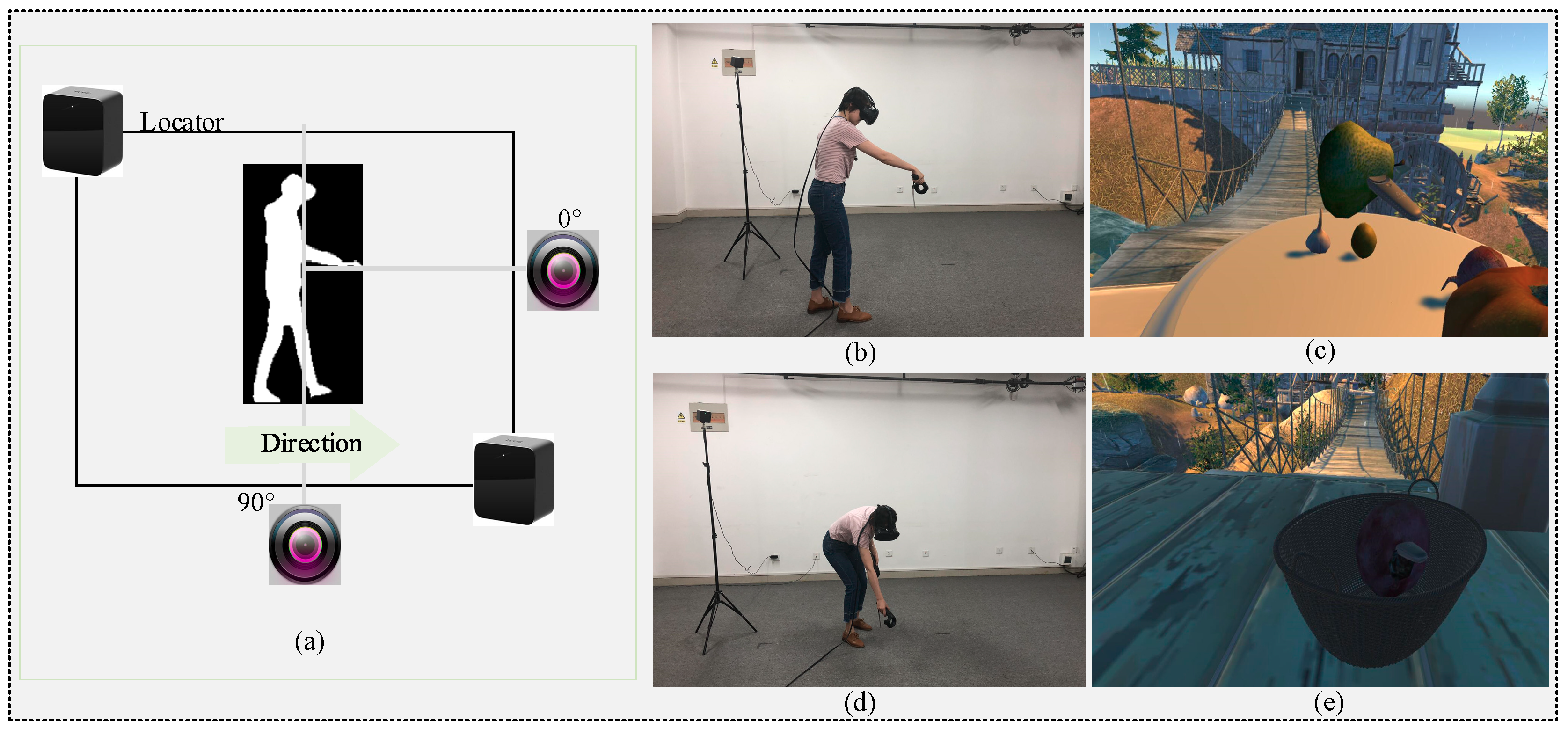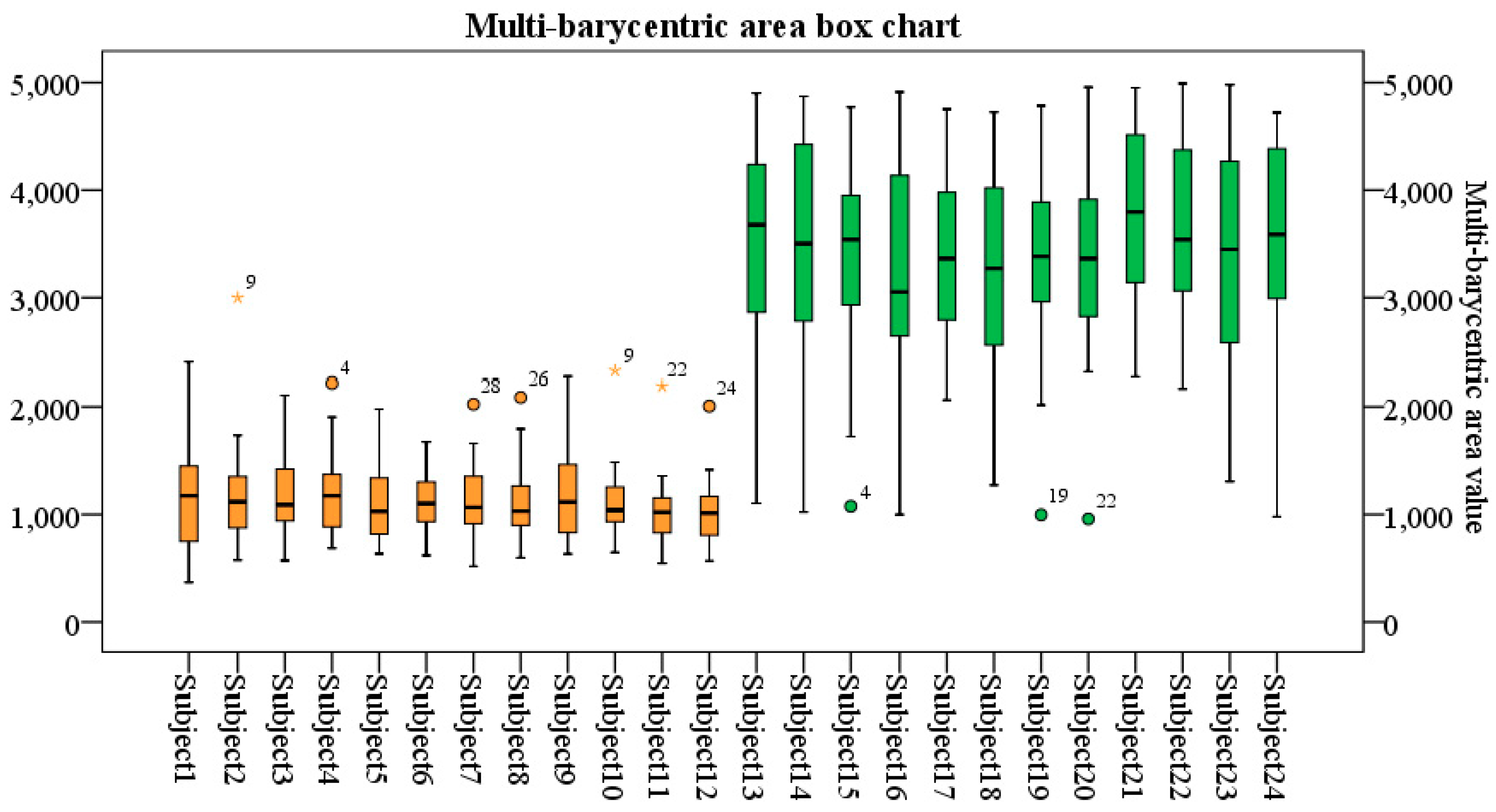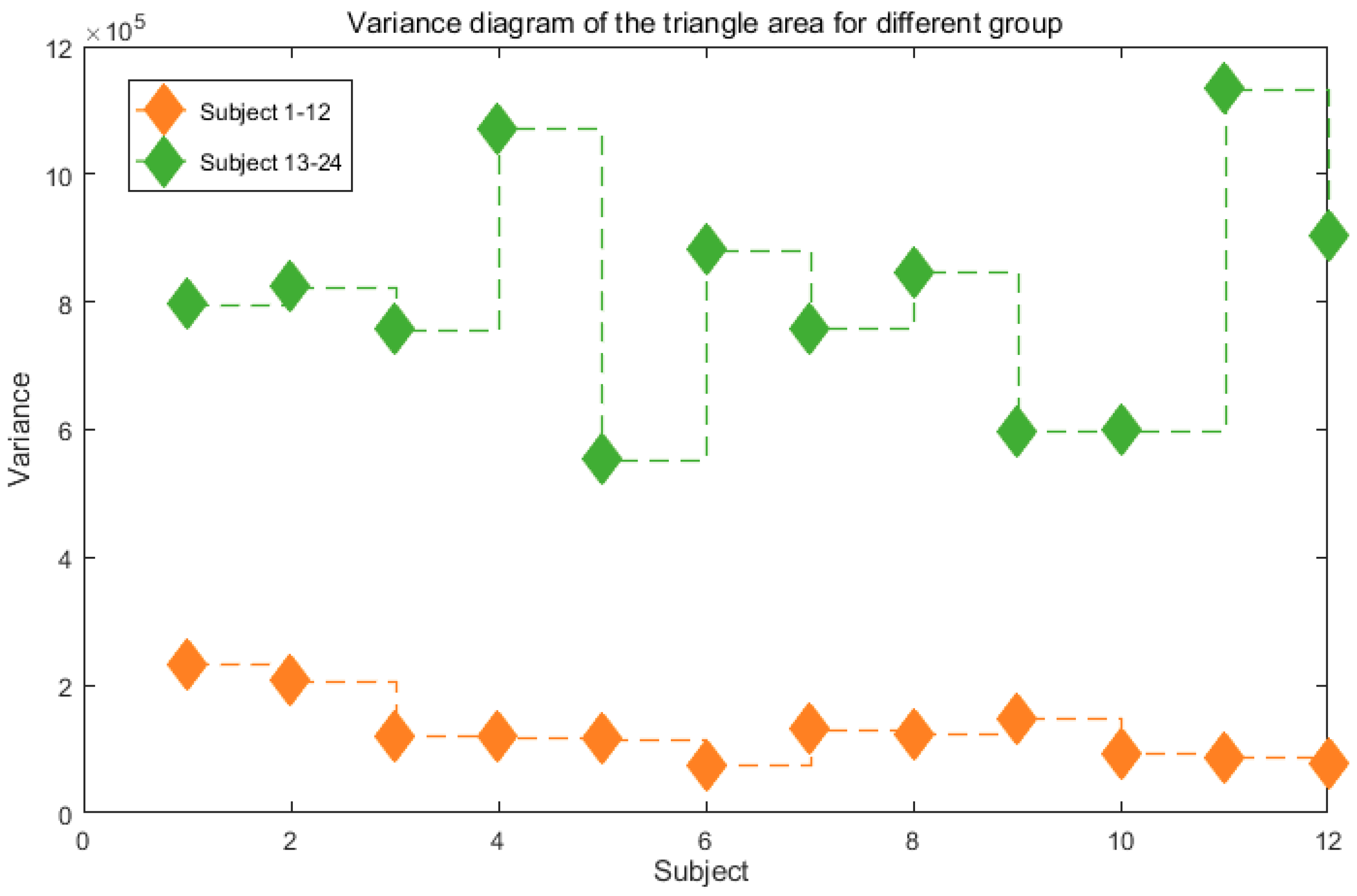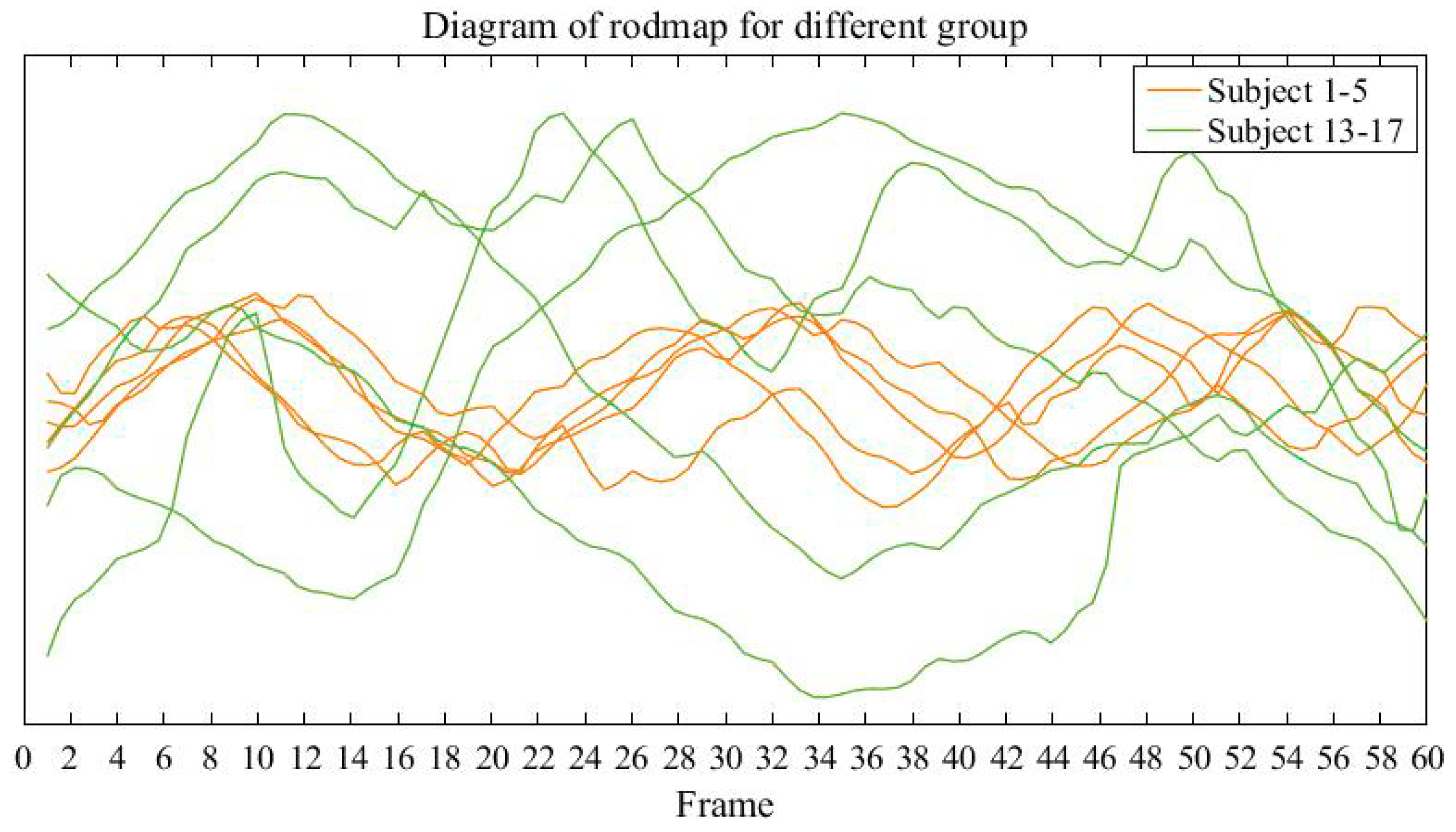Classification for Human Balance Capacity Based on Visual Stimulation under a Virtual Reality Environment
Abstract
1. Introduction
2. Methods
2.1. Participants
2.2. Human Body Posture Modeling
2.3. Human Body Posture Feature Extraction and Classification
- Step 1.
- Video frame preprocessing. Among the obtained experimental video data, taking one frame from each consecutive two frames and save it for further processing, named Ip.
- Step 2.
- Difference algorithm. The image Ip and blank scene Ie are used to make a difference to obtain the difference image Idif [14], as shown in Equation (6).
- Step 3.
- Image denoising. We use a bilateral filter to denoise [15].
- Step 4.
- Using the edge detection operator to process the corroded grayscale image to obtain the connected region of the image [16].
- Step 5.
- The image moments are used to describe feature parameters. An image is a two-dimensional plane, and the pixel value of each point can be regarded as the density of the point. The expectation of that point is the moment of it.
| Feature extraction pseudocode |
| 1: Begin Function 2: Obtain training videos 3: Video image preprocessing. Take one frame from each two consecutive frames and record. 4: Select pure background image without person as Ie. Select images with person walking as Ip. 5: Do image difference (Idif = Ip − Ie). 6: Image denoising using bilateral filtering 7: Search body silhouette using edge detection operator 8: Calculate the smallest rectangle that is perpendicular to the boundary of body silhouette 9: Search the upper, middle and lower barycenter of the human bodyaccording to the image moment, (center1, center2, center3) 10: Calculate the area of a triangle composed of three centers of multiple barycenters. 11: Draw a walking roadmap according to the projection of the triangle. 12: Calculate walking speed of the first half and the second half during the whole walking time, respectively. 13: End function |
2.4. SVM-Based Balance Ability Classification
3. Results
3.1. Analysis of Experimental Results
3.1.1. Analysis of the Multi-Barycentric Area
3.1.2. Analysis of Variance of the Multi-Barycentric Area
3.1.3. Analysis of Roadmap and Moving Speed
4. Discussion
Author Contributions
Funding
Conflicts of Interest
References
- Zhao, W.J.; You, H.; Jiang, S.R.; Zhang, H.X.; Yang, Y.L.; Zhang, M. Effect of Pro-kin visual feedback balance training system on gait stability in patients with cerebral small vessel disease. Medicine 2019, 98, e14503. [Google Scholar] [CrossRef] [PubMed]
- Xie, F.F.; Liu, X.M.; Guo, Z.H. Influencing Factors of Static Balance Posture Diagram. Acta Microsc. 2018, 27, 214–225. [Google Scholar]
- Llorens, R.; Gil-Gomez, J.A.; Alcaniz, M.; Colomer, C.; Noé, E. Improvement in balance using a virtual reality-based stepping exercise: A randomized controlled trial involving individuals with chronic stroke. Clin. Rehabil. 2015, 29, 261–268. [Google Scholar] [CrossRef] [PubMed]
- Calabrò, R.S.; Russo, M.; Naro, A.; De Luca, R.; Leo, A.; Tomasello, P.; Molonia, F.; Dattola, V.; Bramanti, A.; Bramanti, P. Robotic gait training in multiple sclerosis rehabilitation: Can virtual reality make the difference? Findings from a randomized controlled trial. J. Neurol. Sci. 2017, 377, 25–30. [Google Scholar] [CrossRef] [PubMed]
- Cai, Y.; Chia, N.K.; Thalmann, D.; Kee, N.K.; Zheng, J.; Thalmann, N.M. Design and Development of a Virtual Dolphinarium for Children with Autism. IEEE Trans. Neural Syst. Rehabil. Eng. 2013, 21, 208–217. [Google Scholar] [CrossRef] [PubMed]
- Taneja, A.; Vishal, S.B.; Mahesh, V.; Geethanjali, B. Virtual reality based neuro-rehabilitation for mental stress reduction. In Proceedings of the 2017 Fourth International Conference on Signal Processing, Communication and Networking (ICSCN), Chennai, India, 16–18 March 2017; pp. 1–5. [Google Scholar]
- Almajid, R.; Keshner, E.; Wright, W.G.; Tucker, C.; Vasudevan, E. Effect of visual dependence and task loads on the TUG sub-components in old and young adults. In Proceedings of the International Conference on Virtual Rehabilitation, Montreal, QC, Canada, 19–22 June 2017. [Google Scholar]
- Grabowski, P.J.; Mason, A.H. Age differences in the control of a precision reach to grasp task within a desktop virtual environment. Int. J. Hum. Comput. Stud. 2014, 72, 383–392. [Google Scholar] [CrossRef]
- Montuwy, A.; Dommes, A.; Cahour, B. Helping older pedestrians navigate in the city: Comparisons of visual, auditory and haptic guidance instructions in a virtual environment. Behav. Inf. Technol. 2018, 38, 1–22. [Google Scholar] [CrossRef]
- Samadani, A.A.; Moussavi, Z. The effect of aging on human brain spatial processing performance. In Proceedings of the Engineering in Medicine & Biology Society, San Diego, CA, USA, 28 August–1 September 2012; pp. 6768–6771. [Google Scholar]
- Boylan, P.; Kirwan, G.H.; Rooney, B. Self-reported discomfort when using commercially targeted virtual reality equipment in discomfort distraction. Virtual Real. 2018, 22, 309–314. [Google Scholar] [CrossRef]
- Xuan, C. Technological bottleneck of virtual reality. Sci. Technol. Rev. 2016, 34, 94–103. [Google Scholar]
- Pegoraro, P.A.; Angioni, A.; Pau, M.; Monti, A.; Muscas, C.; Ponci, F.; Sulis, S. Bayesian Approach for Distribution System State Estimation with Non-Gaussian Uncertainty Models. IEEE Trans. Instrum. Meas. 2017, 66, 2957–2966. [Google Scholar] [CrossRef]
- Wu, Y.; Wang, Y.; Liu, P.; Luo, H.; Cheng, B.; Sun, H. Infrared LSS-Target Detection Via Adaptive TCAIE-LGM Smoothing and Pixel-Based Background Subtraction. Photonic Sens. 2019, 9, 179–188. [Google Scholar] [CrossRef]
- Veerakumar, T.; Subudhi, B.N.; Esakkirajan, S. Empirical mode decomposition and adaptive bilateral filter approach for impulse noise removal. Expert Syst. Appl. 2018, 121, 18–27. [Google Scholar] [CrossRef]
- Thirumavalavan, S.; Jayaraman, S. An improved teaching–learning based robust edge detection algorithm for noisy images. J. Adv. Res. 2016, 7, 979–989. [Google Scholar] [CrossRef] [PubMed]
- Lakhani, B.; Mansfield, A. Visual feedback of the centre of gravity to optimize standing balance. Gait Posture 2015, 41, 499–503. [Google Scholar] [CrossRef]
- Chau, A.L.; Li, X.; Yu, W. Convex and concave hulls for classification with support vector machine. Neurocomputing 2013, 122, 198–209. [Google Scholar] [CrossRef]
- YANG, T.; QIAN, X.; ZHNG, H. The study of correlation between Pro-Kin balance assessment equipment and Berg balance scale in assess ing balance function of hemiplegic patients with stoke. Chin. J. Rehabil. Med. 2012, 27, 1011–1014. [Google Scholar]
- Kostiukow, A.; Rostkowska, E.; Samborski, W. Assessment of postural balance function. Ann. Acad. Med. Stetin. 2009, 55, 102–109. [Google Scholar] [PubMed]
- Yeh, S.C.; Huang, M.C.; Wang, P.C.; Fang, T.Y.; Su, M.C.; Tsai, P.Y.; Rizzo, A. Machine learning-based assessment tool for imbalance and vestibular dysfunction with virtual reality rehabilitation system. Comput. Methods Programs Biomed. 2014, 116, 311–318. [Google Scholar] [CrossRef] [PubMed]
- Gonzalez, A.M.; Raposo, A.B. Fall Risk Analysis during VR Interaction. In Proceedings of the Virtual & Augmented Reality, Curitiba, Brazil, 1–4 November 2017; pp. 18–28. [Google Scholar]
- LaViola, J.J. A Discussion of Cybersickness in Virtual Environments. ACM Sigchi Bull. 2000, 32, 47–56. [Google Scholar] [CrossRef]







| Data | 387 | 326 | 382 | 297 | 362 | 351 | 310 | 390 | 281 | 353 | 376 | 389 |
| Correct label | 1 | 1 | 1 | 1 | 1 | 1 | 1 | 1 | 1 | 1 | 1 | 1 |
| Test label | 1 | 1 | 1 | 1 | 1 | 1 | 1 | 1 | 1 | 1 | 1 | 1 |
| Data | 378 | 325 | 355 | 382 | 279 | 267 | 372 | 254 | 268 | 367 | 322 | 371 |
| Correct label | −1 | −1 | −1 | −1 | −1 | −1 | −1 | −1 | −1 | −1 | −1 | −1 |
| Test label | −1 | −1 | −1 | −1 | −1 | −1 | −1 | −1 | −1 | −1 | 1 | −1 |
| Subject Category | Experimental Environment | The Number of Subject | Correct Classification | Accuracy |
|---|---|---|---|---|
| The normal (Subject No.1~12) | VR environment | 12 | 12 | 100% |
| Physical environment | 12 | 12 | 100% | |
| The disordered (Subject No.13~24) | VR environment | 12 | 11 | 91.67% |
| Physical environment | 12 | 7 | 58.33% |
© 2019 by the authors. Licensee MDPI, Basel, Switzerland. This article is an open access article distributed under the terms and conditions of the Creative Commons Attribution (CC BY) license (http://creativecommons.org/licenses/by/4.0/).
Share and Cite
Jin, H.; Xie, L.; Xiao, Z.; Zhou, T. Classification for Human Balance Capacity Based on Visual Stimulation under a Virtual Reality Environment. Sensors 2019, 19, 2738. https://doi.org/10.3390/s19122738
Jin H, Xie L, Xiao Z, Zhou T. Classification for Human Balance Capacity Based on Visual Stimulation under a Virtual Reality Environment. Sensors. 2019; 19(12):2738. https://doi.org/10.3390/s19122738
Chicago/Turabian StyleJin, Haiyan, Le Xie, Zhaolin Xiao, and Ting Zhou. 2019. "Classification for Human Balance Capacity Based on Visual Stimulation under a Virtual Reality Environment" Sensors 19, no. 12: 2738. https://doi.org/10.3390/s19122738
APA StyleJin, H., Xie, L., Xiao, Z., & Zhou, T. (2019). Classification for Human Balance Capacity Based on Visual Stimulation under a Virtual Reality Environment. Sensors, 19(12), 2738. https://doi.org/10.3390/s19122738





